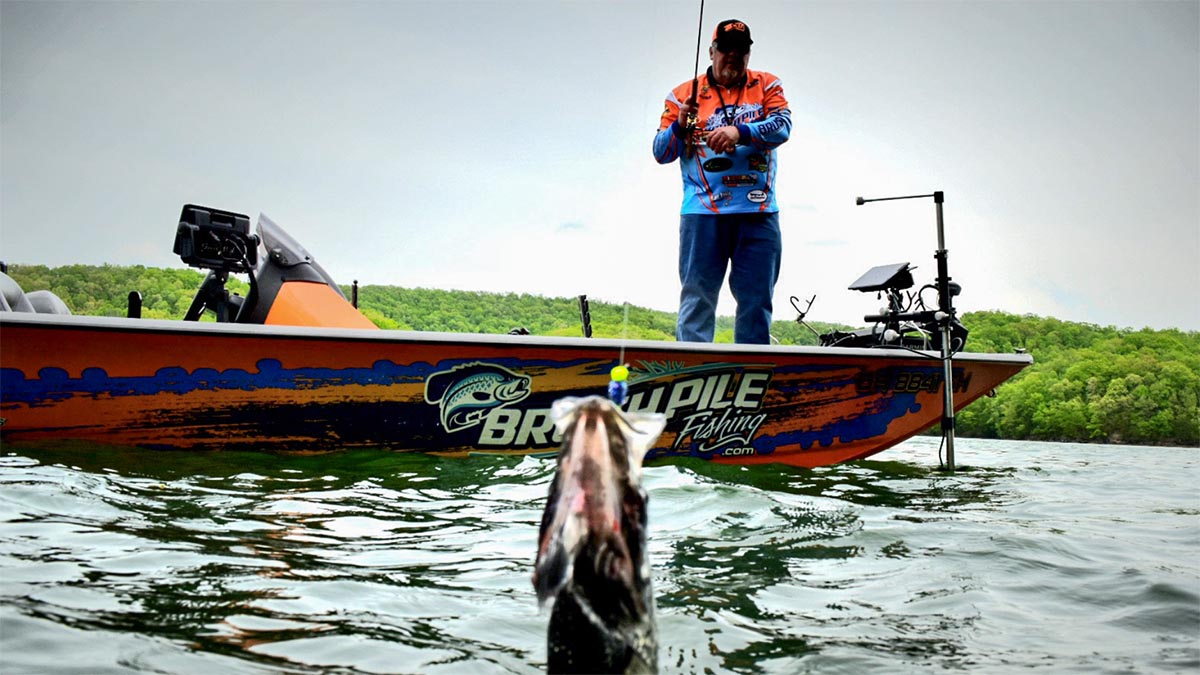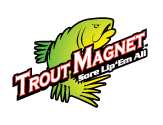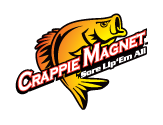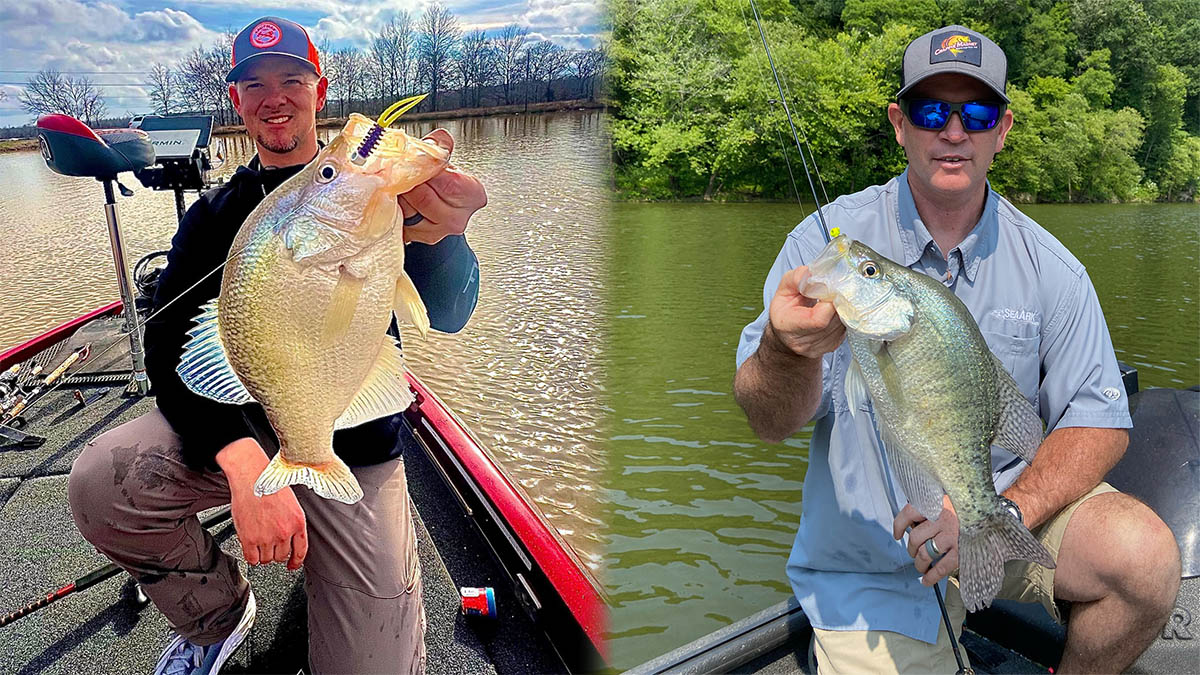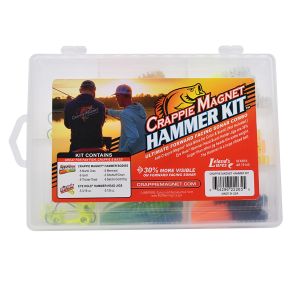Anglers fish for crappie arguably more than any other fish in the country. While they say bass is the most popular fish, probably the most consistent fishing is crappie fishing. They provide a lot of angling opportunities, a lot of fun days on the water and a lot of great eating for those that like to keep fish.
While there are numerous places to catch crappie as well as ways to catch crappie, knowing the best techniques, lures and seasonality of crappie can make your fishing a lot more consistent. This guide will attempt to fill in the gaps for you and put you on a good path to a lot of keeper crappie.
This guide will cover the following aspects of crappie fishing:
- Where to fish for crappie
- Crappie seasonality
- Techniques for crappie
- Best lures for crappie
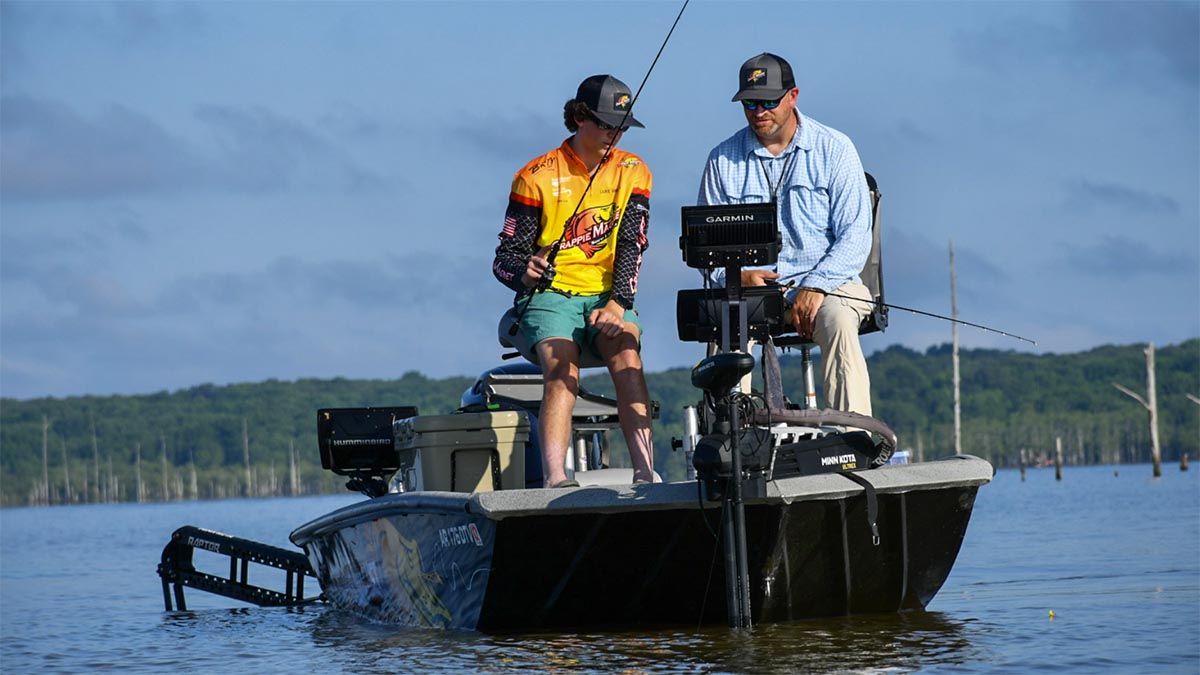
WHERE TO FISH FOR CRAPPIE
Crappie can be caught in a foot of water or 20-plus feet of water depending on season and what conditions exist on the fishery you like to fish.
"The great thing about crappie fishing is crappie can be found in all types of water and just about everywhere you can fish," said Crappie Magnet pro angler Kris Mann. "Crappie can be found in creeks, rivers, ponds, natural lakes and giant man-made reservoirs. If you have stable water and a population of crappie, you generally have good crappie fishing."
Most of where to fish for crappie is related to their place in the migration to and from spawning and then winter and back and forth in between.
"In the spring, fish migrate to shallow water," Mann said. "If there are still cold fronts hitting and the water temps and lunar cycles are not quite there yet, they will stage in areas just outside of the spawning flats that offer cover, quick access to depth, and most importantly, food. These fish are looking to feed up before the stress of spawn comes, and it can be some of the best time of crappie fishing all year for big ones and numbers."
In the prespawn, fish tend to suspend more, warming their eggs and moving shallower in the water column without moving towards the bank. Because of this natural behavior, techniques like long-line trolling, pushing jigs with spider rigs and even casting to individual suspended fish from a distance can all excel for catching fish.
You're looking for bait congregations just outside of those spawning flats and shallow cover. They will get in grass, wood cover in the form of brush piles, standing timber, stumps and laydowns as well as man-made stake beds to feed and wait for the spawning conditions to get right. And they will spawn around this wood cover as well.
They will move into shallow cover, around rocks and logs and brush and spawn and guard their nest and later their fry. Spawning depends on light penetration, longer days, lunar cycles and more. But generally speaking you're going to be targeting fish with just about every technique possible from jig and bobber combos to spider rigging, to dipping shallow wood with jigging rods and more. The clearer the water, the deeper they will spawn. In muddy water they can spawn in a foot of water or less usally around some form of protective cover.
After they spawn, they will move back out to mid-depth cover to recuperate. It can be some tough fishing for a week or two until they rest up from the spawn and guarding and starting feeding heavily again.
As it gets into summer, patterns get more consistent as the fish continue moving out to deeper cover. As a thermocline sets in, you start looking for fish above the thermocline over deep cover.
As you move into fall, fish migrate back shallow with the bait. And they tend to group up a bit more in bigger schools, especially black crappie. They will become more active as the days get shorter. They will get back in more mid depth cover and feed on bait until the water gets down around 50 degrees and then they will start making their way out deep and suspending a lot more for winter.
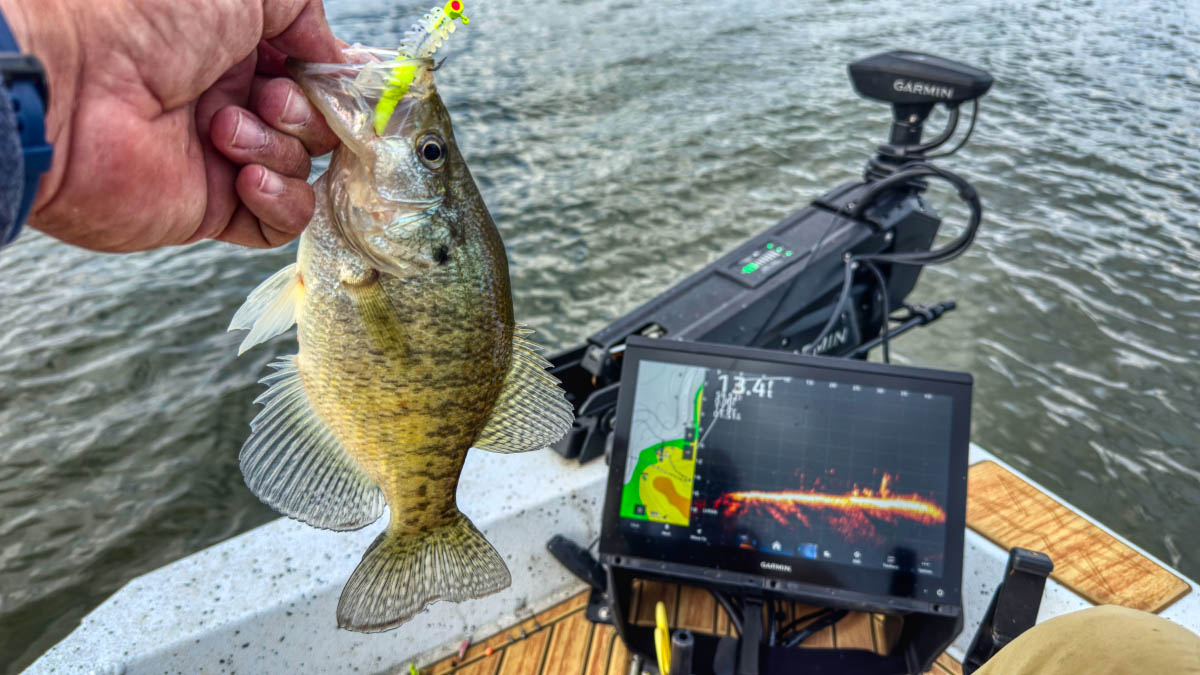
BEST TECHNIQUES FOR CRAPPIE BY SEASON
Several techniques work throughout the year and there's obviously scenarios where one technique works all year. We try to highlight when certain techniques are the best based on season to give you more options to consider from season to season in your crappie fishing.
Spring Crappie Techniques
"In early spring fish are roaming and sunning and letting their eggs warm up while they feed heavily to prepare for the spawn of their eggs that are forming," Mann said. "This is when spider rigging and pushing jigs really excels. You can fish live bait, but double jig rigs have proven dynamite producers over the years.
"I often recommend anglers start with Crappie Magnets, or if the water is warming up a lot, then something with more movement like a Tiny Dancer or a Slab Curly pushed can be even better.
As the fish push shallower, float fishing with a jig under an E-Z Float or slip float can provide a super effective way to target shallow crappie in the spring.
It's also when casting a Crappie Magnet on an Eye Hole Jig or Hammer on a Hammer Head for roaming crappie can be best because those big individual fish are looking for a bit easier meal right on their nose. The Eye Hole jig with a Slab Bite gives you a little extra scent to get a big roamer to commit.
A Slab Curly and a Fin Spin cast in the shallows is also very effective when crappie are aggressive around the spawn.
As the fish move into the post spawn, you are going to be fishing for much more finicky fish and downsizing becomes a very good tactic. That's when dropping down to a Trout Magnet or Pop-Eye Jig vertical jigged or pushed can be deadly on those tight-lipped recuperating spawners.
Summer Crappie Techniques
Summer fishing can be a lot of fun for crappie as you can use more aggressive baits and often bigger baits and a variety of techniques work. As it gets later into the summer and there has been less rain, then staying off of fish and casting gets good both with and without a slip cork. Trolling crankbaits and long line trolling with baits like the Fin Spin Pro Series get really good. Crappie Magnet and Slab Magnet are both good as well.
Playing the morning hours can be a good bet. Get on the water early, catch your fish and get off before the pleasure boaters get out. If you have a good creek or pond with crappie, early and late can be good with fish staying around cover the whole summer and biting best when the light is low.
Fall Crappie Techniques
Single poling gets really good in the fall as fish move back to mid-depth cover and move shallow. Shooting docks is another great technique in the fall. A Crappie Magnet or a Trout Magnet on an Eye Hole Jig or Crappie Magnet Double Cross head are great baits for fall fishing. Also the Pop-Eye Jig shines in the fall. Downsizing from late summer into October is a good idea. And then as water temps get back down in the low 60s and high 50s, your bigger baits play as fish feed up before the cold weather sets in.
"You will often find your clearest water this time of year, so I will often drop down to a 2-pound line with the TCB Rod as it's perfectly suited for that line and cast to fish with downsized baits," Mann said.
"This is also the time of year that I move a lot. I will move from piece to piece of cover with either that TCB rod or my jigging rod and try to hit as many places as I can in a day. If you find a good group of fish schooled up, you can get right in a hurry, but if not moving is the name of the game."
Winter Crappie Techniques
Fishing gets a bit slower in the winter, but you can still catch limits of crappie. They will be really big fish by the end of winter. You can start upsizing as winter progresses and the Eye Hole Hair Jig and Pop-Eye Jig both get very good in the winter as hair moves a little better than plastic in ultra cold waters. This is also a great time to tip any crappie jig with a minnow if you prefer live bait.
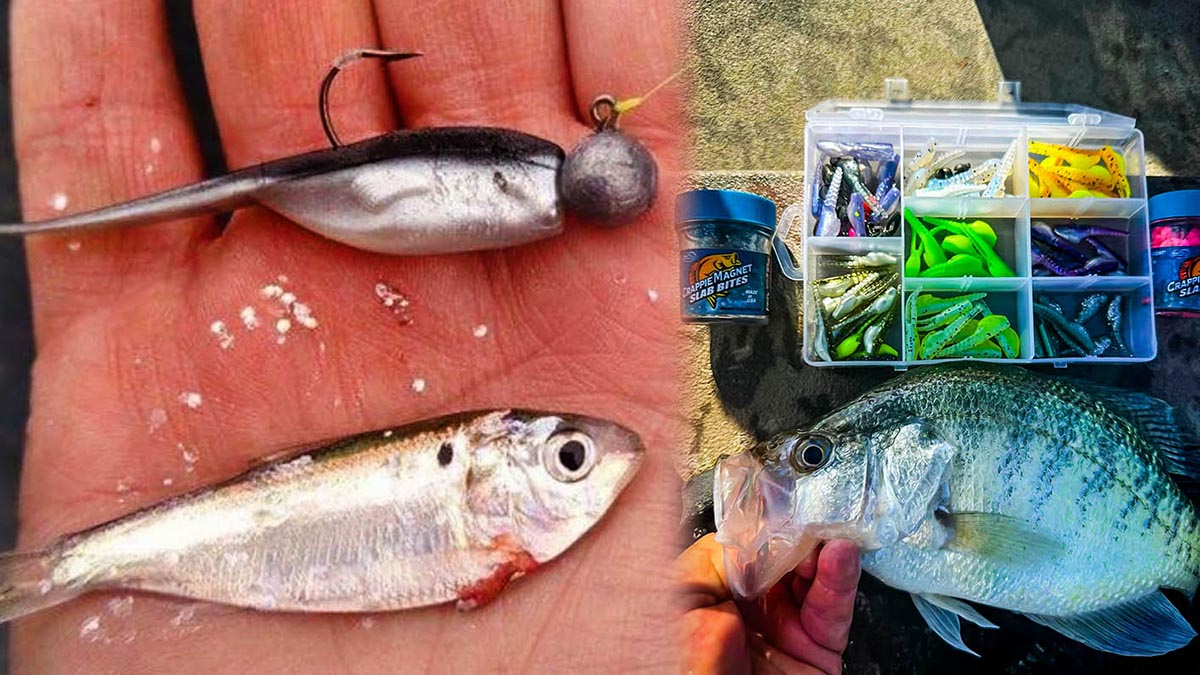
BEST LURES FOR CRAPPIE
We've mentioned a lot of different lures for crappie but just as a quick rundown. You want a shad profile bait, a narrow split tail bait, a bigger profile bait, a curly tail, an under spin, and a hair jig. And I also like a small crappie swimbait. Crappie Magnet offers a complete line of baits that were strategically built and designed with the help of some of the most knowledgeable crappie anglers in the world to make sure you had the right tool for every scenario in fishing.
The Crappie Magnet is an absolute staple in crappie fishing. It can be cast and reeled, pushed, trolled, trolled on a Fin Spin, vertical jigged, shot under docks, tight-lined, dipped in shallow cover and more. The profile mimics everything from minnows to nymphs and looks like food to big hungry crappie. It can be rigged on a Crappie Magnet Head, a Double Cross Jig or an Eye Hole Jig. With Slab Bites and an Eye Hole jig, it is one of the most versatile crappie jigs you can fish from season to season.
The Slab Curly is part shad profile, part curly tail grub and offers the best slow retrieve action when casted, steady reeled or trolled. The tail kicks and flashes at all speeds and is the perfect profile for crappie looking for forage on the move. Rig it on a Double Cross Head or a Fin Spin Eye Hole Jig for the ultimate horizontal presentation.
The All New Brandon Smith Hammer paired with the Hammer Head is the new ultimate big bait for crappie. With uniquely designed ribbed body that traps air and pushes the most water on the retrieve and coupled with the exaggerated split-tail design, the Hammer produces big crappie looking for bigger meals in the prime times. Conquer muddy water roaming and aggressive big crappie in cover with the total big bait package of the Hammer plastic body, Hammer Head Eye Hole Jig and Slab Bites.
The Russ Bailey Roo offers a perfect shad profile with the very unique bait delivery pouch in the belly. You can insert a Slab Bite into the pouch of the Roo to disperse scent slowly and consistently as you vertical jig, shoot and cast the Roo around all your favorite crappie targets.
The Pop Eye Jig offers a compact profile hair jig with longer feathers for a more natural fall and action when jigged vertically around cover for finicky or lethargic cold-water crappie. These baits are durable, effective and the winning ticket with crappie fishing gets tough. These have been staples of crappie anglers in the know for decades.
The Tiny Dancer offers crappie anglers a subtle swimbait action in a crappie profile they can't resist. For shooting docks and casting to open water crappie and over crappie on brush, you won't find a better crappie swimbait that catches. This is one of our favorite small-water baits because it's great for covering water in our favorite crappie ponds and creeks.
The Slab Magnet offers a bigger shad profile when you know the crappie are gorging on bigger minnows and new shad of the year. The Slab Magnet rigged on a 1/8 Eye Hole Jig will give you a winning combination for those stud crappie looking for a bigger meal.
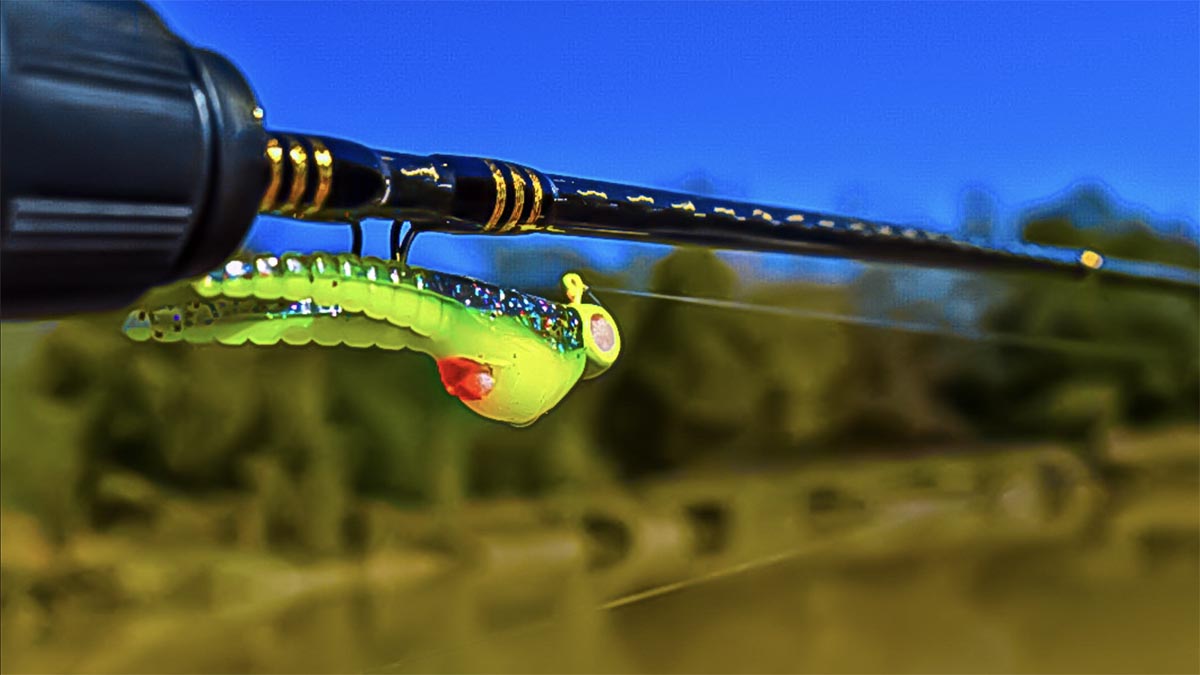
Crappie Lure Colors
We touched briefly on the lure options for crappie. Maybe equally as important is choosing colors that work for your waters and the fishing conditions you face.
"I start by trying to match the color of my lure with the color of the water," Mann said. "If I'm fishing on a crystal clear lake, then I'm going to reach for Shonuff or that translucent glimmer blue or another shad or natural minnow type color. If the water has a green tint to it, them I'm going to lean into those colors with green in them like Mermaid or Wizards Glow. If the water is muddy, them I'm reaching for contrast colors that offer the fish the best chance to see them like black and chartreuse or orange and chartreuse. When it's super muddy, you'd be surprised how good orange colored baits work. Matching that color to the color of that mud pays off huge most of the time."
Crappie Magnet offers 54 colors not because they think you need that many, but because crappie anglers face so many diverse and different water clarities and fisheries across the nation. We have prostaff anglers across the country and a network of great anglers and customers who help us figure out what colors are best on a wide variety of lakes and rivers, so we try to offer the colors our anglers tell us work the best.
"Don't underestimate the importance of color," Mann said. "I have had so many days where one little color change turned the day from just a few bites to non-stop action because we settled in on a color that really triggered the fish.
"I fished a championship recently on Barkley Lake in Kentucky. I was catching some fish in practice but just couldn't get the color dialed in. My father comes in to fish the tournament with me and picks a color neither of us have ever thrown on this lake and every fish we threw at came charging at the bait. I hadn't seen that reaction at all in practice and that one color change made all the difference for us."
Crappie Lure Sizes
Generally speaking you are trying to match the size of your lures to the mood of the fish. If they are aggressive and feeding heavily, you want big baits. If they are lethargic, pressured or just off, you will want to scale down and fish a lot slower generally speaking.
"My rule of thumb for lure size is to use the biggest weight of jig I can get away with," Mann said. "Because that allows me to fish faster and cover more water. Then as I determine the mood of the fish, I can slow down and downsize until I'm presenting exactly what the fish prefer. So I might start with a 1/8-ounce Hammer Head and Hammer jig and cover water, and then when I see they are more picky, I may end up with a 1/64-ounce Pop-Eye Jig on light line to catch my fish. I don't want to fish the 1/64-ounce jig because it will make me 5 times slower fishing. But if that's what the fish prefer, then you just have to settle for less casts and slower presentaions to catch fish."
The depth you are fishing, wind, and aggressiveness of the fish can all dictate what size you should throw. Sometimes you can play around with plastic profile and size and head weight to slow down or speed up a fall to play to the mood of the fish. If you put a Hammer on a real light head, it will fall really slow. But if you put a Crappie Magnet on a middle-weight head, it will fall fast because the profile is so much narrower. So experiment with jig weights and profiles until you are getting more bites.
Hopefully these tips will help you choose the right crappie lures for your waters and fish them in various ways until you really figure the crappie out on your favorite fishing holes. Good luck and Sore Lip 'Em All!
